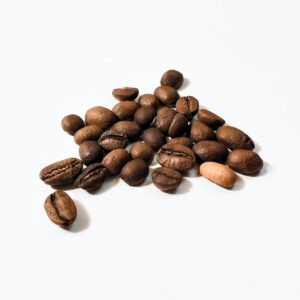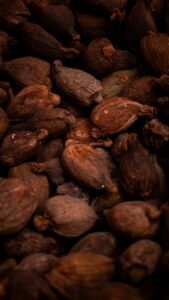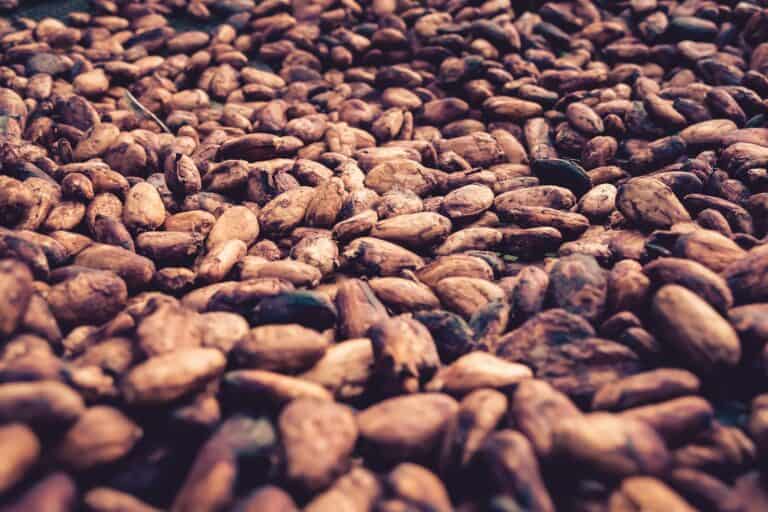When I bite into a piece of chocolate, I’m always amazed by the complexity and richness of its flavor. This delightful experience is largely thanks to the main ingredient in chocolate – cocoa beans. But did you know that the region where the beans are grown can significantly impact their taste? In this article, I’ll explore how the geographical origin of cacao beans influences their flavor profile.
The Theobroma cacao tree is native to the tropical regions of Central and South America, but today, cocoa beans are cultivated in many countries across West Africa, Southeast Asia, and even some parts of Oceania. The cocoa beans are nestled inside large, colorful cocoa pods that grow directly on the trunk of the cacao tree. Each country and region has its own unique climate, soil, and harvest season, which affect the development of the beans and their characteristics.
Discover the importance of sustainability in the chocolate industry with our insights into Ethical Chocolate Production: Sweetness with a Conscience.
Three main varieties of cocoa beans exist – Forastero, Criollo, and Trinitario. Forastero beans, typically grown in West Africa and Southeast Asia, have a robust and more bitter flavor, while Criollo beans, predominantly found in South America, are known for their delicate and aromatic taste. Most craft chocolate makers prefer beans from the Criollo variety due to their nuanced flavor profile and rarity. However, it’s essential to keep in mind that factors such as the fermentation process, cocoa butter content, and chocolate production methods will also impact the final taste of your favorite chocolate bars.

Regional Climate’s Effect on Cocoa Beans
When it comes to the flavor profile of cocoa beans, one crucial factor is the region in which they’re grown. I’ve discovered that environmental factors like temperature, rainfall, and humidity all contribute to the distinct characteristics of cacao beans harvested from different areas around the world.
Firstly, the Theobroma cacao tree thrives in tropical climates with consistent temperature, rainfall, and humidity. This is vital, as the cacao tree’s delicate ecosystem depends on these factors to ensure healthy growth. Generally, regions within 20 degrees latitude of the equator are the perfect ecosystems for cacao trees, including South America, West Africa, and Southeast Asia.
Immerse yourself in the delectable comparison of Belgian and Swiss Chocolate to find out which variety stands out.
Cocoa beans from different regions carry distinct flavors:
– South America: Known for their Criollo variety, cocoa beans here have a fruity, aromatic, and often nutty taste, making them a favorite among craft chocolate makers.
– West Africa: Predominantly producing the Forastero variety, beans from this region have a bolder, more robust flavor, making them popular in mass-produced chocolate bars.
– Southeast Asia: This region produces a mix of Criollo, Forastero, and Trinitario, resulting in complex and unique flavor profiles in chocolates.
The harvest season also plays a significant role in the flavor profile of cocoa beans. During the cacao tree’s fruiting period, the cocoa pods ripen, and the beans within them develop their flavors. Cocoa farmers must carefully monitor the ripening process and select the optimal time to harvest the pods, as this greatly impacts the final taste of the chocolate produced.
Explore the rich history and cultural significance of Chocolate in Ancient Civilizations to uncover its role in early societies.
Another crucial factor in flavor development is the fermentation of cocoa beans. Once harvested, beans are left in piles to ferment for varying amounts of time. The length of fermentation has a significant impact on the flavor profile, with longer fermentation resulting in a more complex, intense taste.
Lastly, cocoa bean processing can also impact flavor. Techniques such as roasting, grinding, and mixing with sugar and cocoa butter influence the final taste of chocolate products. Craft chocolate makers are often more inclined to use ethically-sourced, high-quality beans, and time-honored production methods to create unique and premium chocolates.
To sum up, the environment and practices in a specific region substantially affect the flavor of cacao beans. From the climate conditions where cacao trees grow to the processing of beans, all these elements ultimately shape the taste profile of chocolates around the world. In order to experience the various flavors that cocoa has to offer, I encourage you to try chocolate from different countries and dive deep into the world of cocoa.
Soil Composition and Cocoa Flavor Profiles

When it comes to chocolate production, one crucial factor in determining the flavor profile is the soil composition in which the cacao tree is grown. Not all cocoa beans are created equal; various factors like climate, terrain, and soil nutrients contribute to the unique characteristics of each cocoa bean. With diverse locations for cacao trees around the world, especially in West Africa, South America, and Southeast Asia, the regional differences play a massive role in developing distinct flavor profiles.
Cocoa beans, sourced from Theobroma cacao tree pods, can vary greatly based on the tree’s nutrients found in the soil. There are three main varieties of cacao trees: Criollo, Forastero, and Trinitario. Each has their own unique characteristics and flavor profiles:
– Criollo beans: Native to South America, these beans are rare, making up only a small percentage of the global cocoa supply chain. Known for their delicate, aromatic, and fruity flavor, Criollo beans are highly sought after by craft chocolate makers.
– Forastero beans: Originating in West Africa, this variety is the most widely grown, accounting for nearly 80% of the world’s cocoa production. Forastero beans have a bold, robust flavor, making them the backbone of many common chocolate bars.
– Trinitario beans: A hybrid of both Criollo and Forastero varieties, these beans combine the complex flavors of Criollo with the hardiness of Forastero. Trinitario beans are grown throughout the cocoa-producing regions, contributing to a wide range of chocolate creations.
Cacao trees absorb minerals from the soil, which directly impacts the flavor profiles of the cocoa beans. For instance, an increase in nitrogen leads to higher cocoa butter content, giving the beans a smoother and creamier flavor profile. Other vital elements found in the soil, such as magnesium, potassium, and phosphorus, affect the bitterness, astringency, and overall taste of cocoa beans.
Enhance your culinary experience with our guide to finding Perfect Chocolate and Wine Combinations that will delight your palate
Apart from soil composition, post-harvesting processes like fermentation and drying play a significant role in developing cocoa beans’ flavor profile. Properly fermented beans emphasize the cocoa’s natural taste, while inadequate fermentation could result in off-flavors or muted profiles.
Being cognizant of region and soil composition is vital for chocolate makers and consumers alike, as it directly impacts the final product’s taste. Additionally, supporting fair trade cocoa initiatives ensures that farmers who cultivate these flavorful beans receive proper wages and working conditions. So next time you indulge in a piece of chocolate, remember that the region, soil, and cacao tree variety all play a part in creating the delicious treat you’re enjoying.
Final Thoughts: The Role of Region in Cocoa’s Taste
When it comes to cocoa beans, the region in which they’re grown plays a significant role in their flavor profile. Cacao trees, or Theobroma Cacao trees, produce cocoa beans that are key ingredients in many products such as chocolate bars, cocoa powder, and cocoa butter. The distinct taste of these products largely depends on the unique characteristics of the raw beans, which are influenced by factors like climate, soil, and farming practices.
Discover creative ideas for unforgettable events with our tips on choosing the best Chocolate Party Favors for your guests.
Cocoa beans come in various types, with the prominent ones being the Criollo, Forastero, and Trinitario varieties. The flavor of chocolate products relies heavily on the specific bean type used:
– Criollo beans: Known for their fine taste and premium quality, these beans are predominantly found in South America.
– Forastero beans: Mostly grown in West Africa, Southeast Asia, and many countries around the world, these beans are more robust and have a stronger cacao flavor.
– Trinitario beans: A hybrid variety of the two, offering a balanced and complex flavor profile.
The process of fermentation contributes to the development of the beans’ distinct flavor. Fermented beans are sun-dried, roasted, and can be transformed into cocoa paste or chocolate liquor, leading to other essential products like chocolate bars, nibs, and cocoa powder. The quality and taste of these items depend on factors like harvest season, preparation of the beans, and the care taken by farmers throughout the supply chain.
Fair trade cocoa is an essential aspect of the industry, as it ensures equitable treatment for farmers, sustainable practices, and a better quality of cocoa beans, which ultimately results in a superior taste. Many craft chocolate makers prioritize using fair trade cocoa and focus on creating unique, flavor-packed chocolates that celebrate the diverse origins of their key ingredient – the humble cocoa bean.
In conclusion, the region in which cocoa beans are grown has a significant impact on their flavor, and this is what determines the vast range of chocolate products available to us. Whether it’s a luxurious dark chocolate bar made from Criollo beans or a fruit-infused chocolate treat using Forastero beans, the diverse flavors all derive from the magnificent cacao plant. As consumers, we can savor and appreciate the health benefits of these chocolates while supporting ethical and sustainable practices throughout the world.
